University Report: Mental Health Challenges in New Zealand, 2017
VerifiedAdded on 2020/04/07
|9
|2344
|44
Report
AI Summary
This submission report addresses the critical mental health challenges facing New Zealand. The report, submitted by the Mental Health Foundation of New Zealand, highlights the rising prevalence of mental disorders like anxiety, depression, and bipolar disorders, affecting a significant portion of the population. It explores factors contributing to high suicide rates, particularly among youth, and emphasizes the impact of social issues, including discrimination and poverty. The report supports the intent of the Mental Health Challenges Bill and provides detailed comments on clauses, recommending interventions such as early life interventions for children from poor socioeconomic backgrounds and integration of primary and specialist care services. It references relevant policies and legislation, including the Health and Safety at Work Act 2015, and suggests approaches to improve mental health promotion and monitoring, ensuring better use of resources and access to services, especially for remote communities and vulnerable populations. The report also provides recommendations including intervention strategies at an early stage with relation to the children coming from poor socioeconomic backgrounds. Early life interventions will prevent the development of mental illnesses at a later stage of life.
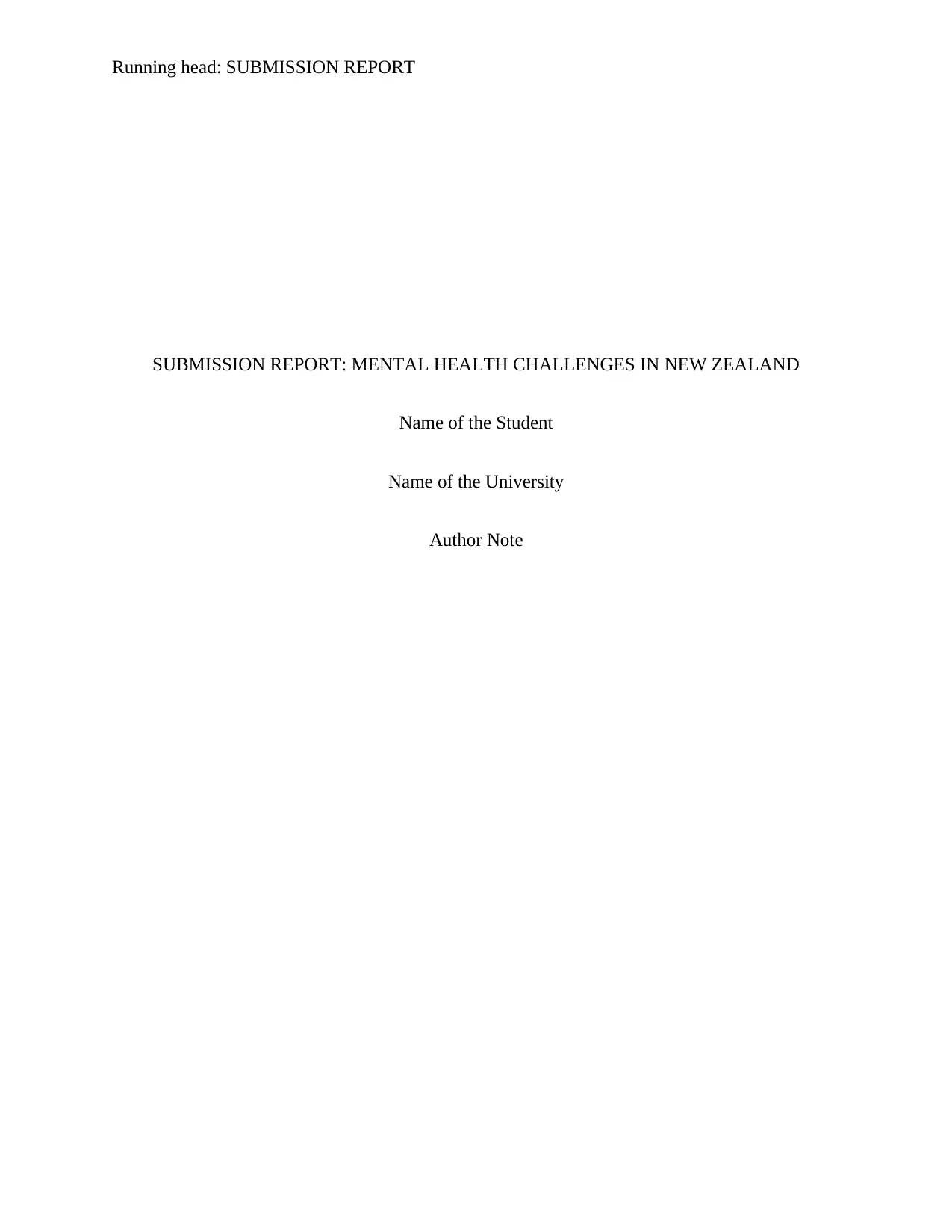
Running head: SUBMISSION REPORT
SUBMISSION REPORT: MENTAL HEALTH CHALLENGES IN NEW ZEALAND
Name of the Student
Name of the University
Author Note
SUBMISSION REPORT: MENTAL HEALTH CHALLENGES IN NEW ZEALAND
Name of the Student
Name of the University
Author Note
Paraphrase This Document
Need a fresh take? Get an instant paraphrase of this document with our AI Paraphraser
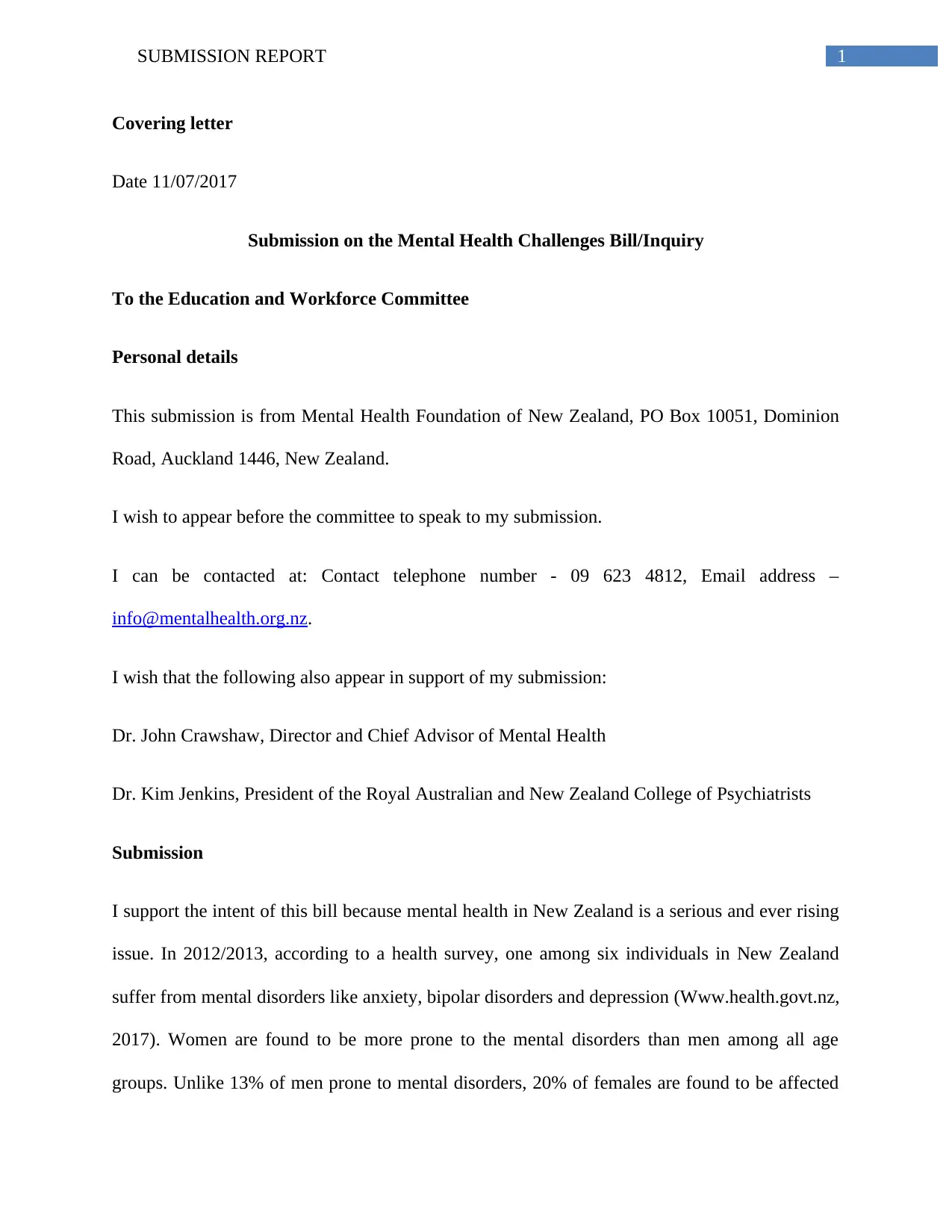
1SUBMISSION REPORT
Covering letter
Date 11/07/2017
Submission on the Mental Health Challenges Bill/Inquiry
To the Education and Workforce Committee
Personal details
This submission is from Mental Health Foundation of New Zealand, PO Box 10051, Dominion
Road, Auckland 1446, New Zealand.
I wish to appear before the committee to speak to my submission.
I can be contacted at: Contact telephone number - 09 623 4812, Email address –
info@mentalhealth.org.nz.
I wish that the following also appear in support of my submission:
Dr. John Crawshaw, Director and Chief Advisor of Mental Health
Dr. Kim Jenkins, President of the Royal Australian and New Zealand College of Psychiatrists
Submission
I support the intent of this bill because mental health in New Zealand is a serious and ever rising
issue. In 2012/2013, according to a health survey, one among six individuals in New Zealand
suffer from mental disorders like anxiety, bipolar disorders and depression (Www.health.govt.nz,
2017). Women are found to be more prone to the mental disorders than men among all age
groups. Unlike 13% of men prone to mental disorders, 20% of females are found to be affected
Covering letter
Date 11/07/2017
Submission on the Mental Health Challenges Bill/Inquiry
To the Education and Workforce Committee
Personal details
This submission is from Mental Health Foundation of New Zealand, PO Box 10051, Dominion
Road, Auckland 1446, New Zealand.
I wish to appear before the committee to speak to my submission.
I can be contacted at: Contact telephone number - 09 623 4812, Email address –
info@mentalhealth.org.nz.
I wish that the following also appear in support of my submission:
Dr. John Crawshaw, Director and Chief Advisor of Mental Health
Dr. Kim Jenkins, President of the Royal Australian and New Zealand College of Psychiatrists
Submission
I support the intent of this bill because mental health in New Zealand is a serious and ever rising
issue. In 2012/2013, according to a health survey, one among six individuals in New Zealand
suffer from mental disorders like anxiety, bipolar disorders and depression (Www.health.govt.nz,
2017). Women are found to be more prone to the mental disorders than men among all age
groups. Unlike 13% of men prone to mental disorders, 20% of females are found to be affected
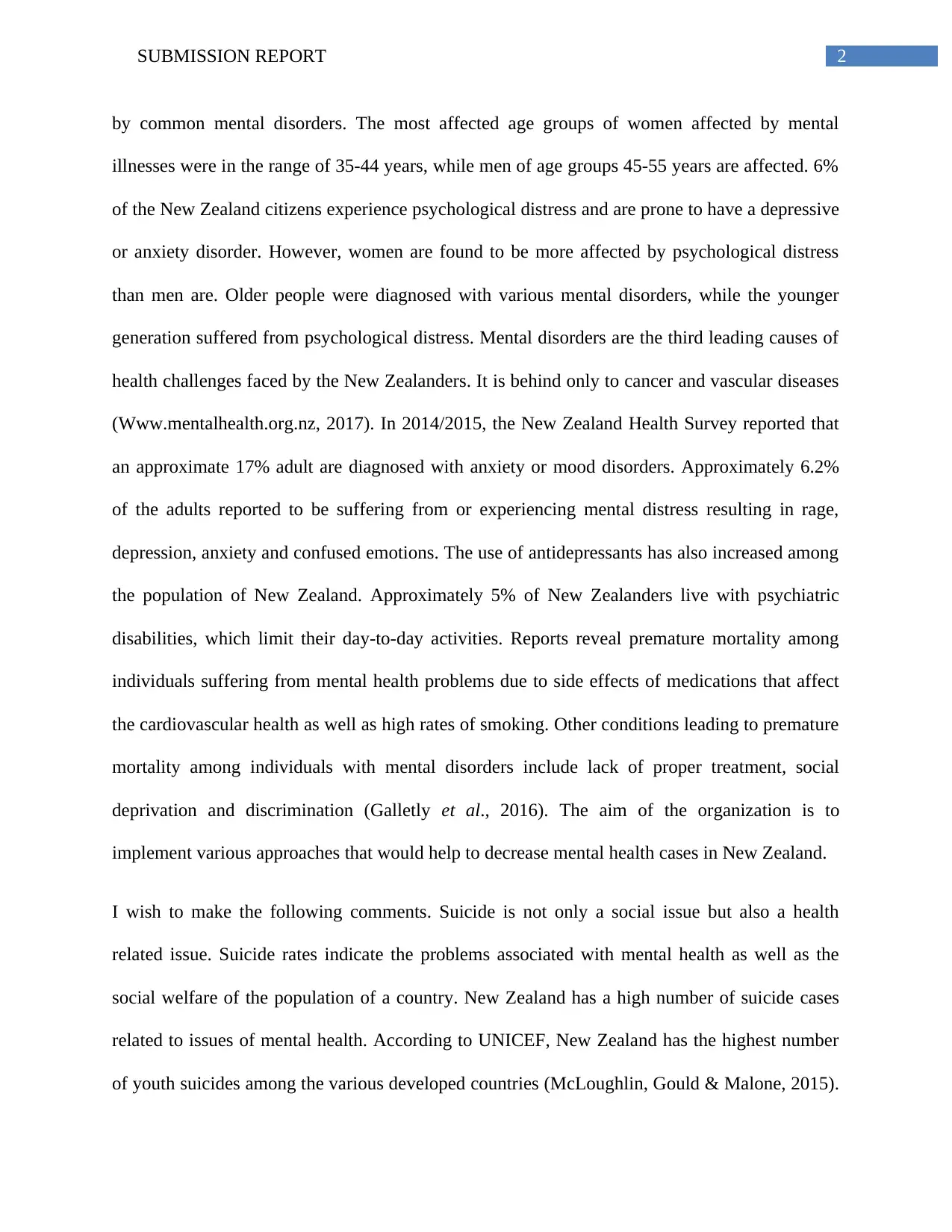
2SUBMISSION REPORT
by common mental disorders. The most affected age groups of women affected by mental
illnesses were in the range of 35-44 years, while men of age groups 45-55 years are affected. 6%
of the New Zealand citizens experience psychological distress and are prone to have a depressive
or anxiety disorder. However, women are found to be more affected by psychological distress
than men are. Older people were diagnosed with various mental disorders, while the younger
generation suffered from psychological distress. Mental disorders are the third leading causes of
health challenges faced by the New Zealanders. It is behind only to cancer and vascular diseases
(Www.mentalhealth.org.nz, 2017). In 2014/2015, the New Zealand Health Survey reported that
an approximate 17% adult are diagnosed with anxiety or mood disorders. Approximately 6.2%
of the adults reported to be suffering from or experiencing mental distress resulting in rage,
depression, anxiety and confused emotions. The use of antidepressants has also increased among
the population of New Zealand. Approximately 5% of New Zealanders live with psychiatric
disabilities, which limit their day-to-day activities. Reports reveal premature mortality among
individuals suffering from mental health problems due to side effects of medications that affect
the cardiovascular health as well as high rates of smoking. Other conditions leading to premature
mortality among individuals with mental disorders include lack of proper treatment, social
deprivation and discrimination (Galletly et al., 2016). The aim of the organization is to
implement various approaches that would help to decrease mental health cases in New Zealand.
I wish to make the following comments. Suicide is not only a social issue but also a health
related issue. Suicide rates indicate the problems associated with mental health as well as the
social welfare of the population of a country. New Zealand has a high number of suicide cases
related to issues of mental health. According to UNICEF, New Zealand has the highest number
of youth suicides among the various developed countries (McLoughlin, Gould & Malone, 2015).
by common mental disorders. The most affected age groups of women affected by mental
illnesses were in the range of 35-44 years, while men of age groups 45-55 years are affected. 6%
of the New Zealand citizens experience psychological distress and are prone to have a depressive
or anxiety disorder. However, women are found to be more affected by psychological distress
than men are. Older people were diagnosed with various mental disorders, while the younger
generation suffered from psychological distress. Mental disorders are the third leading causes of
health challenges faced by the New Zealanders. It is behind only to cancer and vascular diseases
(Www.mentalhealth.org.nz, 2017). In 2014/2015, the New Zealand Health Survey reported that
an approximate 17% adult are diagnosed with anxiety or mood disorders. Approximately 6.2%
of the adults reported to be suffering from or experiencing mental distress resulting in rage,
depression, anxiety and confused emotions. The use of antidepressants has also increased among
the population of New Zealand. Approximately 5% of New Zealanders live with psychiatric
disabilities, which limit their day-to-day activities. Reports reveal premature mortality among
individuals suffering from mental health problems due to side effects of medications that affect
the cardiovascular health as well as high rates of smoking. Other conditions leading to premature
mortality among individuals with mental disorders include lack of proper treatment, social
deprivation and discrimination (Galletly et al., 2016). The aim of the organization is to
implement various approaches that would help to decrease mental health cases in New Zealand.
I wish to make the following comments. Suicide is not only a social issue but also a health
related issue. Suicide rates indicate the problems associated with mental health as well as the
social welfare of the population of a country. New Zealand has a high number of suicide cases
related to issues of mental health. According to UNICEF, New Zealand has the highest number
of youth suicides among the various developed countries (McLoughlin, Gould & Malone, 2015).
⊘ This is a preview!⊘
Do you want full access?
Subscribe today to unlock all pages.

Trusted by 1+ million students worldwide
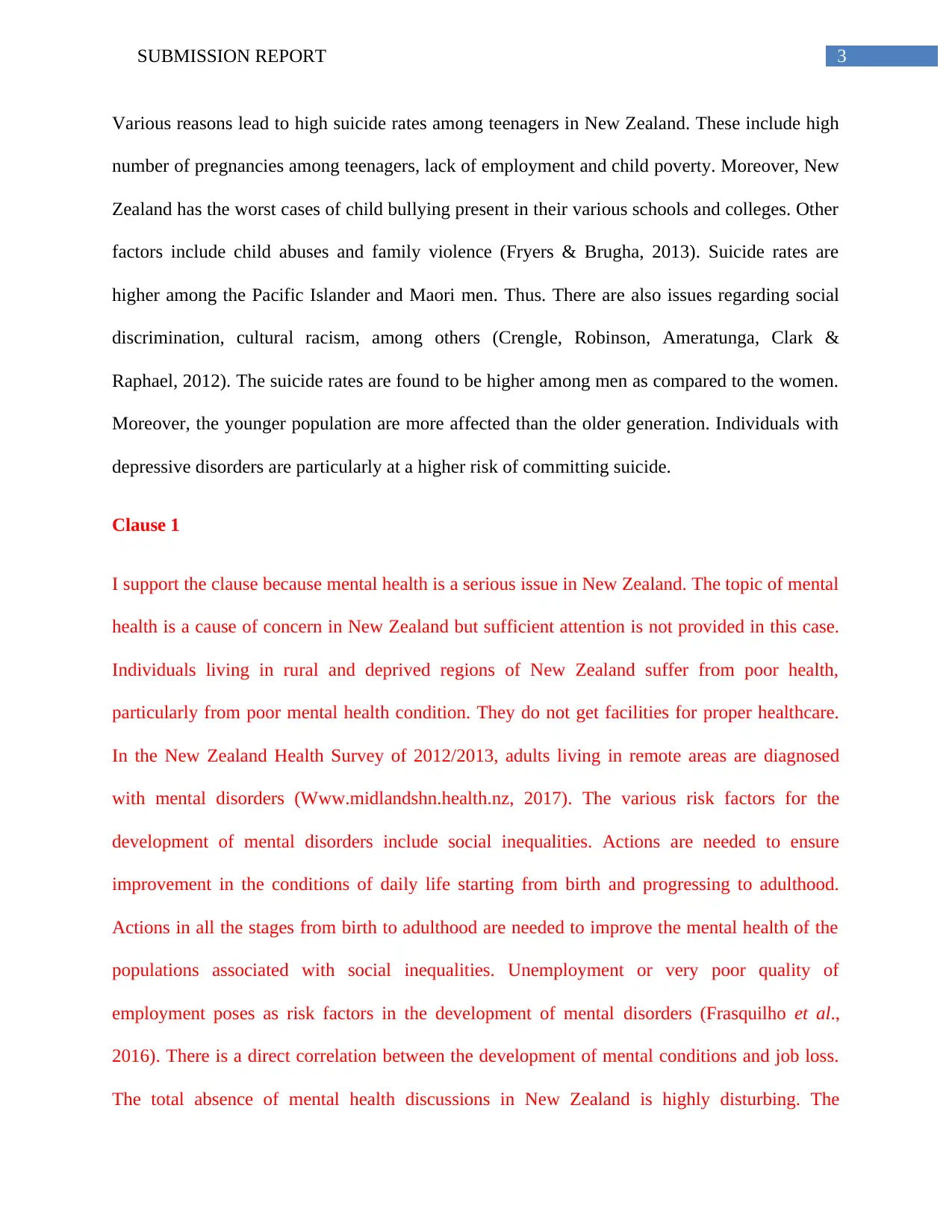
3SUBMISSION REPORT
Various reasons lead to high suicide rates among teenagers in New Zealand. These include high
number of pregnancies among teenagers, lack of employment and child poverty. Moreover, New
Zealand has the worst cases of child bullying present in their various schools and colleges. Other
factors include child abuses and family violence (Fryers & Brugha, 2013). Suicide rates are
higher among the Pacific Islander and Maori men. Thus. There are also issues regarding social
discrimination, cultural racism, among others (Crengle, Robinson, Ameratunga, Clark &
Raphael, 2012). The suicide rates are found to be higher among men as compared to the women.
Moreover, the younger population are more affected than the older generation. Individuals with
depressive disorders are particularly at a higher risk of committing suicide.
Clause 1
I support the clause because mental health is a serious issue in New Zealand. The topic of mental
health is a cause of concern in New Zealand but sufficient attention is not provided in this case.
Individuals living in rural and deprived regions of New Zealand suffer from poor health,
particularly from poor mental health condition. They do not get facilities for proper healthcare.
In the New Zealand Health Survey of 2012/2013, adults living in remote areas are diagnosed
with mental disorders (Www.midlandshn.health.nz, 2017). The various risk factors for the
development of mental disorders include social inequalities. Actions are needed to ensure
improvement in the conditions of daily life starting from birth and progressing to adulthood.
Actions in all the stages from birth to adulthood are needed to improve the mental health of the
populations associated with social inequalities. Unemployment or very poor quality of
employment poses as risk factors in the development of mental disorders (Frasquilho et al.,
2016). There is a direct correlation between the development of mental conditions and job loss.
The total absence of mental health discussions in New Zealand is highly disturbing. The
Various reasons lead to high suicide rates among teenagers in New Zealand. These include high
number of pregnancies among teenagers, lack of employment and child poverty. Moreover, New
Zealand has the worst cases of child bullying present in their various schools and colleges. Other
factors include child abuses and family violence (Fryers & Brugha, 2013). Suicide rates are
higher among the Pacific Islander and Maori men. Thus. There are also issues regarding social
discrimination, cultural racism, among others (Crengle, Robinson, Ameratunga, Clark &
Raphael, 2012). The suicide rates are found to be higher among men as compared to the women.
Moreover, the younger population are more affected than the older generation. Individuals with
depressive disorders are particularly at a higher risk of committing suicide.
Clause 1
I support the clause because mental health is a serious issue in New Zealand. The topic of mental
health is a cause of concern in New Zealand but sufficient attention is not provided in this case.
Individuals living in rural and deprived regions of New Zealand suffer from poor health,
particularly from poor mental health condition. They do not get facilities for proper healthcare.
In the New Zealand Health Survey of 2012/2013, adults living in remote areas are diagnosed
with mental disorders (Www.midlandshn.health.nz, 2017). The various risk factors for the
development of mental disorders include social inequalities. Actions are needed to ensure
improvement in the conditions of daily life starting from birth and progressing to adulthood.
Actions in all the stages from birth to adulthood are needed to improve the mental health of the
populations associated with social inequalities. Unemployment or very poor quality of
employment poses as risk factors in the development of mental disorders (Frasquilho et al.,
2016). There is a direct correlation between the development of mental conditions and job loss.
The total absence of mental health discussions in New Zealand is highly disturbing. The
Paraphrase This Document
Need a fresh take? Get an instant paraphrase of this document with our AI Paraphraser
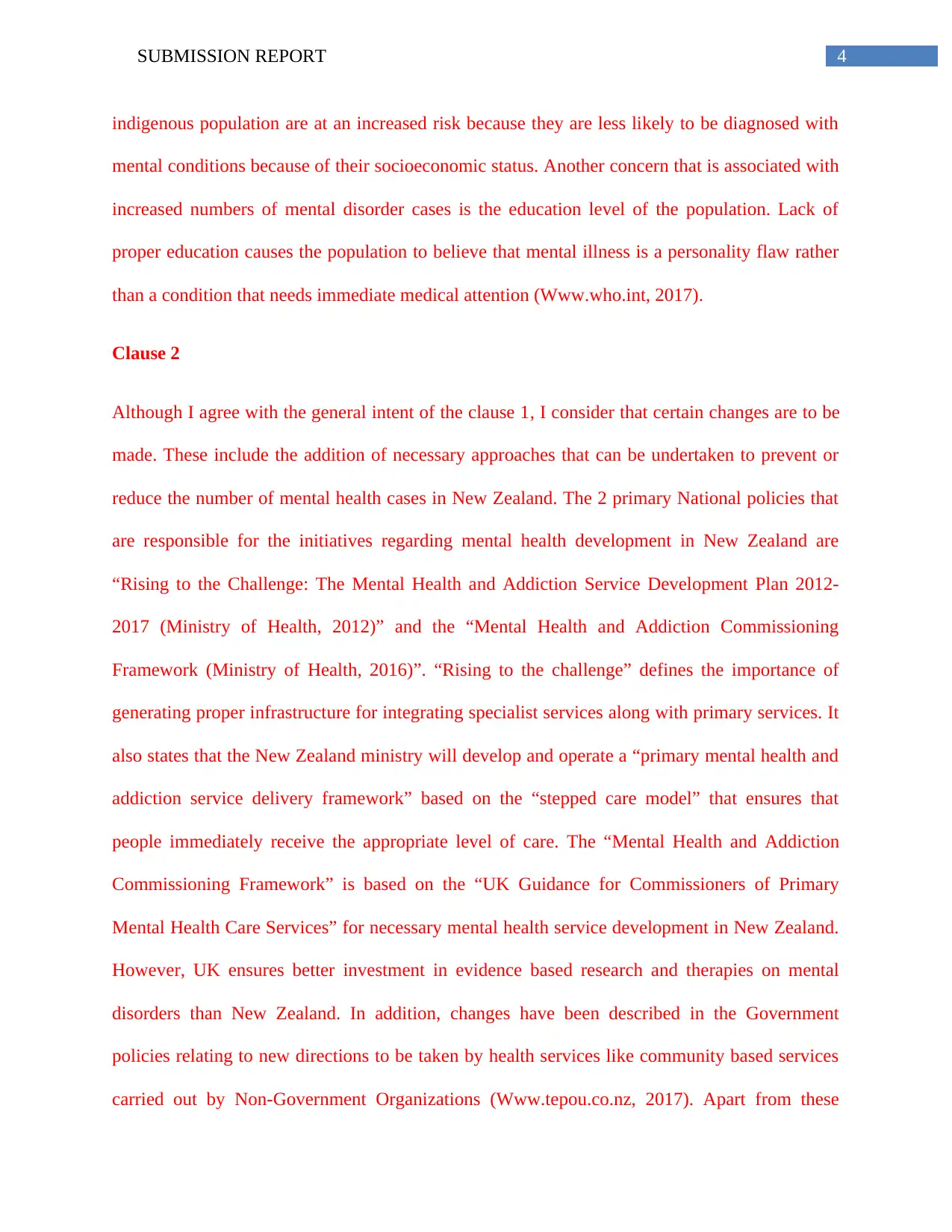
4SUBMISSION REPORT
indigenous population are at an increased risk because they are less likely to be diagnosed with
mental conditions because of their socioeconomic status. Another concern that is associated with
increased numbers of mental disorder cases is the education level of the population. Lack of
proper education causes the population to believe that mental illness is a personality flaw rather
than a condition that needs immediate medical attention (Www.who.int, 2017).
Clause 2
Although I agree with the general intent of the clause 1, I consider that certain changes are to be
made. These include the addition of necessary approaches that can be undertaken to prevent or
reduce the number of mental health cases in New Zealand. The 2 primary National policies that
are responsible for the initiatives regarding mental health development in New Zealand are
“Rising to the Challenge: The Mental Health and Addiction Service Development Plan 2012-
2017 (Ministry of Health, 2012)” and the “Mental Health and Addiction Commissioning
Framework (Ministry of Health, 2016)”. “Rising to the challenge” defines the importance of
generating proper infrastructure for integrating specialist services along with primary services. It
also states that the New Zealand ministry will develop and operate a “primary mental health and
addiction service delivery framework” based on the “stepped care model” that ensures that
people immediately receive the appropriate level of care. The “Mental Health and Addiction
Commissioning Framework” is based on the “UK Guidance for Commissioners of Primary
Mental Health Care Services” for necessary mental health service development in New Zealand.
However, UK ensures better investment in evidence based research and therapies on mental
disorders than New Zealand. In addition, changes have been described in the Government
policies relating to new directions to be taken by health services like community based services
carried out by Non-Government Organizations (Www.tepou.co.nz, 2017). Apart from these
indigenous population are at an increased risk because they are less likely to be diagnosed with
mental conditions because of their socioeconomic status. Another concern that is associated with
increased numbers of mental disorder cases is the education level of the population. Lack of
proper education causes the population to believe that mental illness is a personality flaw rather
than a condition that needs immediate medical attention (Www.who.int, 2017).
Clause 2
Although I agree with the general intent of the clause 1, I consider that certain changes are to be
made. These include the addition of necessary approaches that can be undertaken to prevent or
reduce the number of mental health cases in New Zealand. The 2 primary National policies that
are responsible for the initiatives regarding mental health development in New Zealand are
“Rising to the Challenge: The Mental Health and Addiction Service Development Plan 2012-
2017 (Ministry of Health, 2012)” and the “Mental Health and Addiction Commissioning
Framework (Ministry of Health, 2016)”. “Rising to the challenge” defines the importance of
generating proper infrastructure for integrating specialist services along with primary services. It
also states that the New Zealand ministry will develop and operate a “primary mental health and
addiction service delivery framework” based on the “stepped care model” that ensures that
people immediately receive the appropriate level of care. The “Mental Health and Addiction
Commissioning Framework” is based on the “UK Guidance for Commissioners of Primary
Mental Health Care Services” for necessary mental health service development in New Zealand.
However, UK ensures better investment in evidence based research and therapies on mental
disorders than New Zealand. In addition, changes have been described in the Government
policies relating to new directions to be taken by health services like community based services
carried out by Non-Government Organizations (Www.tepou.co.nz, 2017). Apart from these
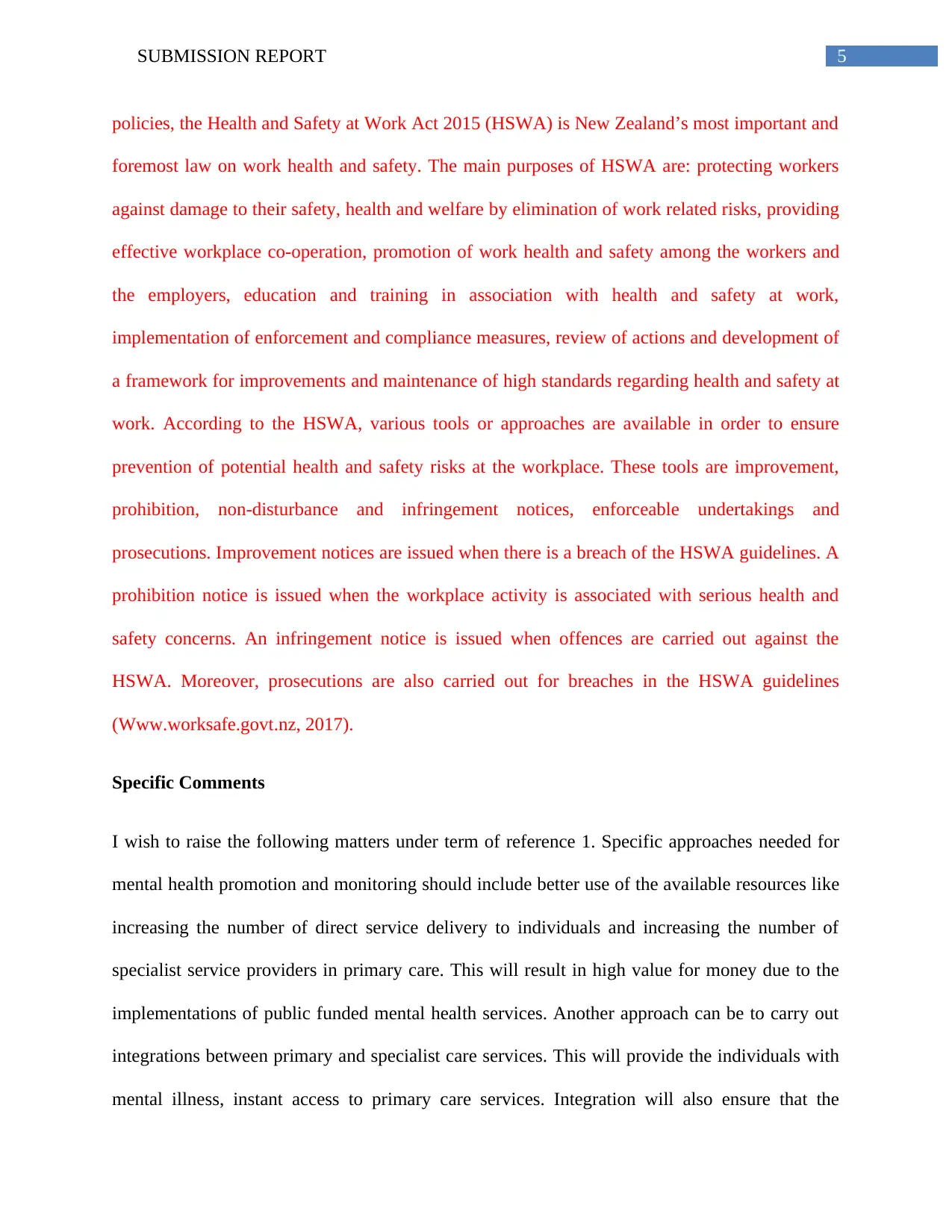
5SUBMISSION REPORT
policies, the Health and Safety at Work Act 2015 (HSWA) is New Zealand’s most important and
foremost law on work health and safety. The main purposes of HSWA are: protecting workers
against damage to their safety, health and welfare by elimination of work related risks, providing
effective workplace co-operation, promotion of work health and safety among the workers and
the employers, education and training in association with health and safety at work,
implementation of enforcement and compliance measures, review of actions and development of
a framework for improvements and maintenance of high standards regarding health and safety at
work. According to the HSWA, various tools or approaches are available in order to ensure
prevention of potential health and safety risks at the workplace. These tools are improvement,
prohibition, non-disturbance and infringement notices, enforceable undertakings and
prosecutions. Improvement notices are issued when there is a breach of the HSWA guidelines. A
prohibition notice is issued when the workplace activity is associated with serious health and
safety concerns. An infringement notice is issued when offences are carried out against the
HSWA. Moreover, prosecutions are also carried out for breaches in the HSWA guidelines
(Www.worksafe.govt.nz, 2017).
Specific Comments
I wish to raise the following matters under term of reference 1. Specific approaches needed for
mental health promotion and monitoring should include better use of the available resources like
increasing the number of direct service delivery to individuals and increasing the number of
specialist service providers in primary care. This will result in high value for money due to the
implementations of public funded mental health services. Another approach can be to carry out
integrations between primary and specialist care services. This will provide the individuals with
mental illness, instant access to primary care services. Integration will also ensure that the
policies, the Health and Safety at Work Act 2015 (HSWA) is New Zealand’s most important and
foremost law on work health and safety. The main purposes of HSWA are: protecting workers
against damage to their safety, health and welfare by elimination of work related risks, providing
effective workplace co-operation, promotion of work health and safety among the workers and
the employers, education and training in association with health and safety at work,
implementation of enforcement and compliance measures, review of actions and development of
a framework for improvements and maintenance of high standards regarding health and safety at
work. According to the HSWA, various tools or approaches are available in order to ensure
prevention of potential health and safety risks at the workplace. These tools are improvement,
prohibition, non-disturbance and infringement notices, enforceable undertakings and
prosecutions. Improvement notices are issued when there is a breach of the HSWA guidelines. A
prohibition notice is issued when the workplace activity is associated with serious health and
safety concerns. An infringement notice is issued when offences are carried out against the
HSWA. Moreover, prosecutions are also carried out for breaches in the HSWA guidelines
(Www.worksafe.govt.nz, 2017).
Specific Comments
I wish to raise the following matters under term of reference 1. Specific approaches needed for
mental health promotion and monitoring should include better use of the available resources like
increasing the number of direct service delivery to individuals and increasing the number of
specialist service providers in primary care. This will result in high value for money due to the
implementations of public funded mental health services. Another approach can be to carry out
integrations between primary and specialist care services. This will provide the individuals with
mental illness, instant access to primary care services. Integration will also ensure that the
⊘ This is a preview!⊘
Do you want full access?
Subscribe today to unlock all pages.

Trusted by 1+ million students worldwide
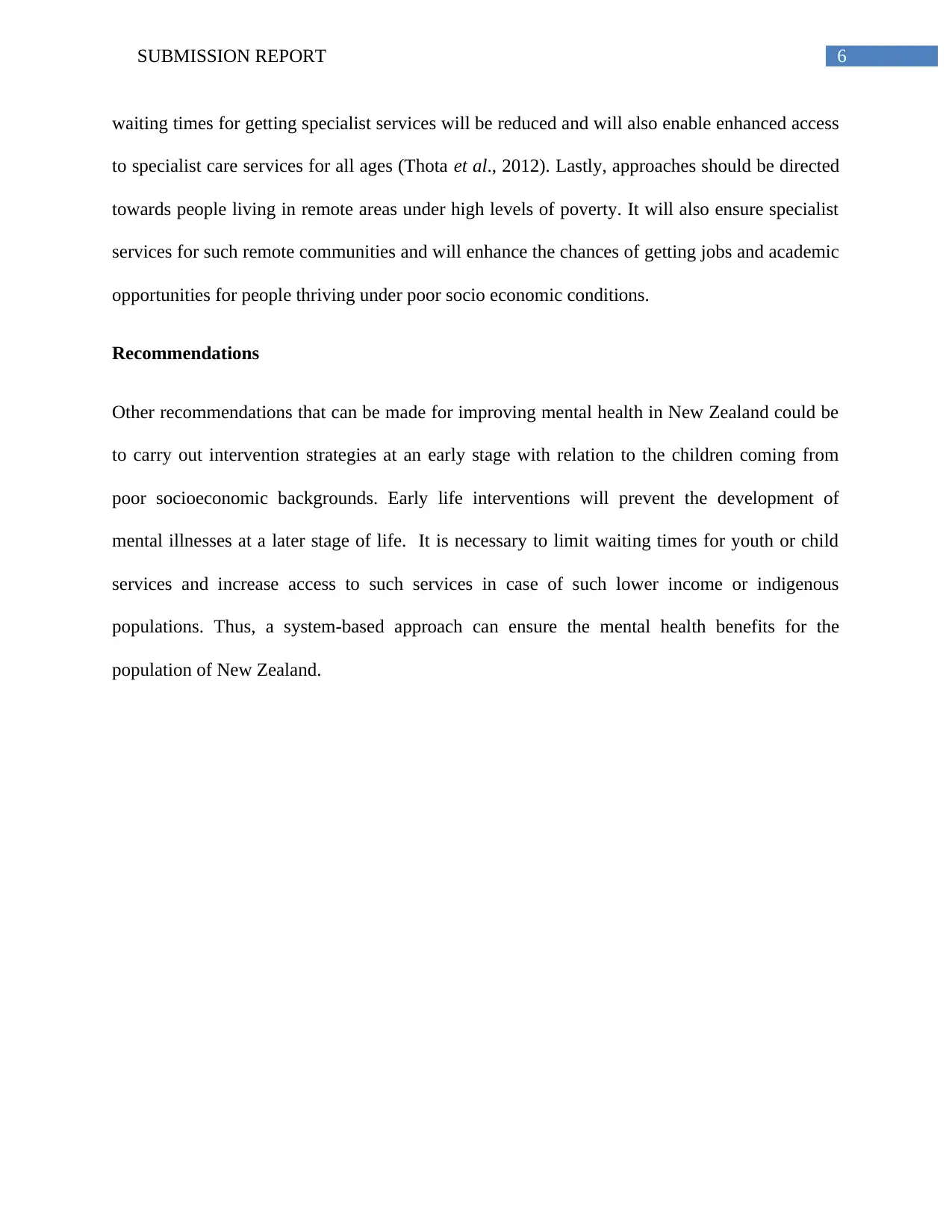
6SUBMISSION REPORT
waiting times for getting specialist services will be reduced and will also enable enhanced access
to specialist care services for all ages (Thota et al., 2012). Lastly, approaches should be directed
towards people living in remote areas under high levels of poverty. It will also ensure specialist
services for such remote communities and will enhance the chances of getting jobs and academic
opportunities for people thriving under poor socio economic conditions.
Recommendations
Other recommendations that can be made for improving mental health in New Zealand could be
to carry out intervention strategies at an early stage with relation to the children coming from
poor socioeconomic backgrounds. Early life interventions will prevent the development of
mental illnesses at a later stage of life. It is necessary to limit waiting times for youth or child
services and increase access to such services in case of such lower income or indigenous
populations. Thus, a system-based approach can ensure the mental health benefits for the
population of New Zealand.
waiting times for getting specialist services will be reduced and will also enable enhanced access
to specialist care services for all ages (Thota et al., 2012). Lastly, approaches should be directed
towards people living in remote areas under high levels of poverty. It will also ensure specialist
services for such remote communities and will enhance the chances of getting jobs and academic
opportunities for people thriving under poor socio economic conditions.
Recommendations
Other recommendations that can be made for improving mental health in New Zealand could be
to carry out intervention strategies at an early stage with relation to the children coming from
poor socioeconomic backgrounds. Early life interventions will prevent the development of
mental illnesses at a later stage of life. It is necessary to limit waiting times for youth or child
services and increase access to such services in case of such lower income or indigenous
populations. Thus, a system-based approach can ensure the mental health benefits for the
population of New Zealand.
Paraphrase This Document
Need a fresh take? Get an instant paraphrase of this document with our AI Paraphraser
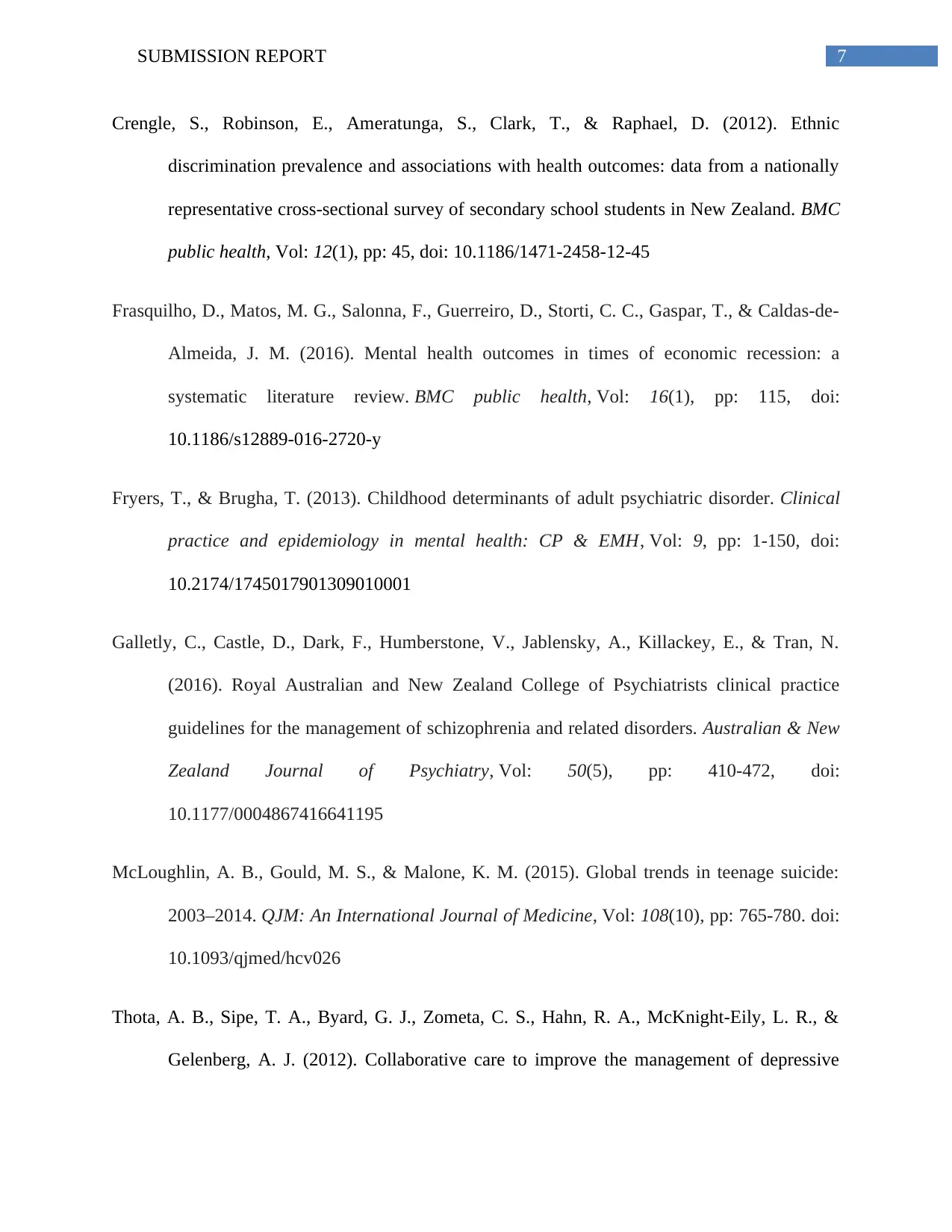
7SUBMISSION REPORT
Crengle, S., Robinson, E., Ameratunga, S., Clark, T., & Raphael, D. (2012). Ethnic
discrimination prevalence and associations with health outcomes: data from a nationally
representative cross-sectional survey of secondary school students in New Zealand. BMC
public health, Vol: 12(1), pp: 45, doi: 10.1186/1471-2458-12-45
Frasquilho, D., Matos, M. G., Salonna, F., Guerreiro, D., Storti, C. C., Gaspar, T., & Caldas-de-
Almeida, J. M. (2016). Mental health outcomes in times of economic recession: a
systematic literature review. BMC public health, Vol: 16(1), pp: 115, doi:
10.1186/s12889-016-2720-y
Fryers, T., & Brugha, T. (2013). Childhood determinants of adult psychiatric disorder. Clinical
practice and epidemiology in mental health: CP & EMH, Vol: 9, pp: 1-150, doi:
10.2174/1745017901309010001
Galletly, C., Castle, D., Dark, F., Humberstone, V., Jablensky, A., Killackey, E., & Tran, N.
(2016). Royal Australian and New Zealand College of Psychiatrists clinical practice
guidelines for the management of schizophrenia and related disorders. Australian & New
Zealand Journal of Psychiatry, Vol: 50(5), pp: 410-472, doi:
10.1177/0004867416641195
McLoughlin, A. B., Gould, M. S., & Malone, K. M. (2015). Global trends in teenage suicide:
2003–2014. QJM: An International Journal of Medicine, Vol: 108(10), pp: 765-780. doi:
10.1093/qjmed/hcv026
Thota, A. B., Sipe, T. A., Byard, G. J., Zometa, C. S., Hahn, R. A., McKnight-Eily, L. R., &
Gelenberg, A. J. (2012). Collaborative care to improve the management of depressive
Crengle, S., Robinson, E., Ameratunga, S., Clark, T., & Raphael, D. (2012). Ethnic
discrimination prevalence and associations with health outcomes: data from a nationally
representative cross-sectional survey of secondary school students in New Zealand. BMC
public health, Vol: 12(1), pp: 45, doi: 10.1186/1471-2458-12-45
Frasquilho, D., Matos, M. G., Salonna, F., Guerreiro, D., Storti, C. C., Gaspar, T., & Caldas-de-
Almeida, J. M. (2016). Mental health outcomes in times of economic recession: a
systematic literature review. BMC public health, Vol: 16(1), pp: 115, doi:
10.1186/s12889-016-2720-y
Fryers, T., & Brugha, T. (2013). Childhood determinants of adult psychiatric disorder. Clinical
practice and epidemiology in mental health: CP & EMH, Vol: 9, pp: 1-150, doi:
10.2174/1745017901309010001
Galletly, C., Castle, D., Dark, F., Humberstone, V., Jablensky, A., Killackey, E., & Tran, N.
(2016). Royal Australian and New Zealand College of Psychiatrists clinical practice
guidelines for the management of schizophrenia and related disorders. Australian & New
Zealand Journal of Psychiatry, Vol: 50(5), pp: 410-472, doi:
10.1177/0004867416641195
McLoughlin, A. B., Gould, M. S., & Malone, K. M. (2015). Global trends in teenage suicide:
2003–2014. QJM: An International Journal of Medicine, Vol: 108(10), pp: 765-780. doi:
10.1093/qjmed/hcv026
Thota, A. B., Sipe, T. A., Byard, G. J., Zometa, C. S., Hahn, R. A., McKnight-Eily, L. R., &
Gelenberg, A. J. (2012). Collaborative care to improve the management of depressive
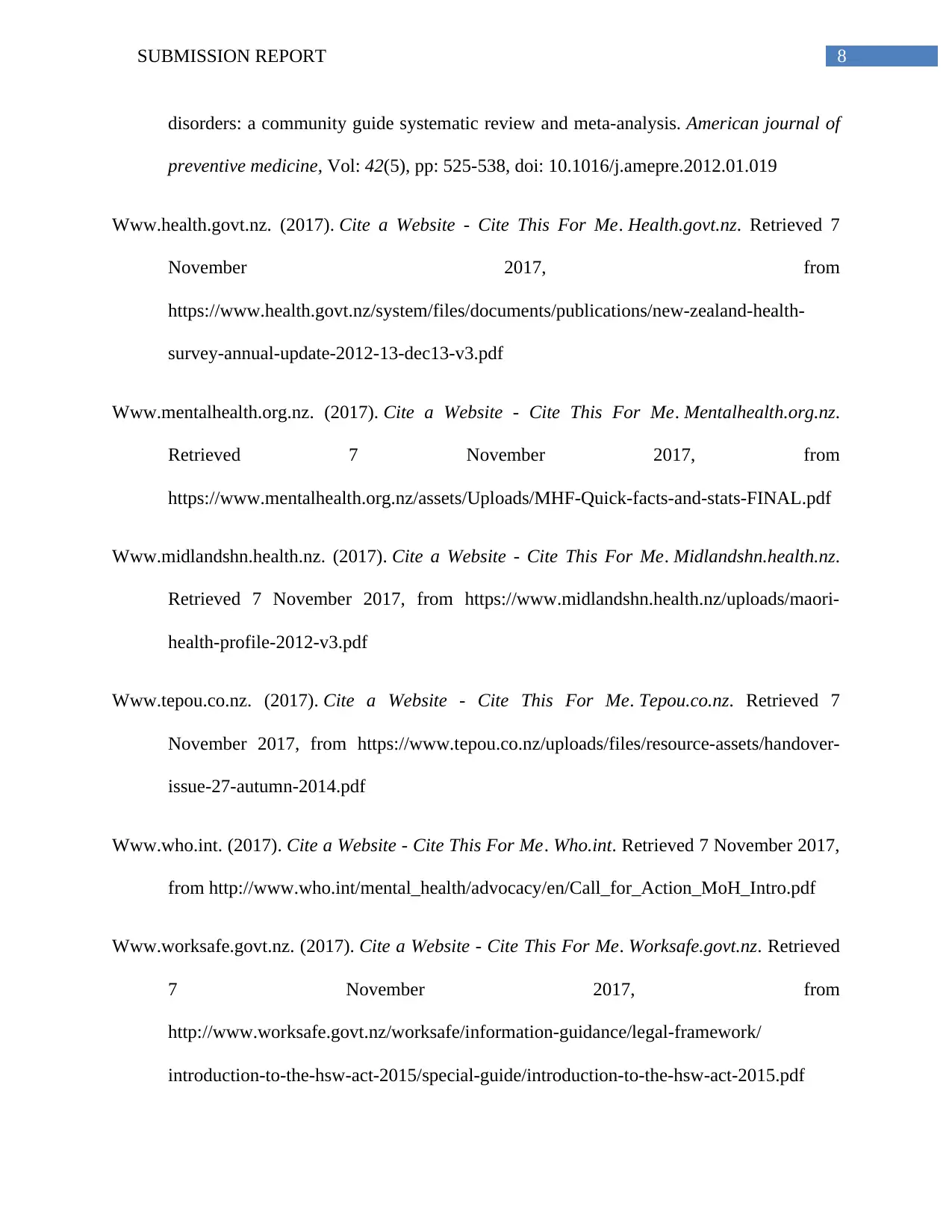
8SUBMISSION REPORT
disorders: a community guide systematic review and meta-analysis. American journal of
preventive medicine, Vol: 42(5), pp: 525-538, doi: 10.1016/j.amepre.2012.01.019
Www.health.govt.nz. (2017). Cite a Website - Cite This For Me. Health.govt.nz. Retrieved 7
November 2017, from
https://www.health.govt.nz/system/files/documents/publications/new-zealand-health-
survey-annual-update-2012-13-dec13-v3.pdf
Www.mentalhealth.org.nz. (2017). Cite a Website - Cite This For Me. Mentalhealth.org.nz.
Retrieved 7 November 2017, from
https://www.mentalhealth.org.nz/assets/Uploads/MHF-Quick-facts-and-stats-FINAL.pdf
Www.midlandshn.health.nz. (2017). Cite a Website - Cite This For Me. Midlandshn.health.nz.
Retrieved 7 November 2017, from https://www.midlandshn.health.nz/uploads/maori-
health-profile-2012-v3.pdf
Www.tepou.co.nz. (2017). Cite a Website - Cite This For Me. Tepou.co.nz. Retrieved 7
November 2017, from https://www.tepou.co.nz/uploads/files/resource-assets/handover-
issue-27-autumn-2014.pdf
Www.who.int. (2017). Cite a Website - Cite This For Me. Who.int. Retrieved 7 November 2017,
from http://www.who.int/mental_health/advocacy/en/Call_for_Action_MoH_Intro.pdf
Www.worksafe.govt.nz. (2017). Cite a Website - Cite This For Me. Worksafe.govt.nz. Retrieved
7 November 2017, from
http://www.worksafe.govt.nz/worksafe/information-guidance/legal-framework/
introduction-to-the-hsw-act-2015/special-guide/introduction-to-the-hsw-act-2015.pdf
disorders: a community guide systematic review and meta-analysis. American journal of
preventive medicine, Vol: 42(5), pp: 525-538, doi: 10.1016/j.amepre.2012.01.019
Www.health.govt.nz. (2017). Cite a Website - Cite This For Me. Health.govt.nz. Retrieved 7
November 2017, from
https://www.health.govt.nz/system/files/documents/publications/new-zealand-health-
survey-annual-update-2012-13-dec13-v3.pdf
Www.mentalhealth.org.nz. (2017). Cite a Website - Cite This For Me. Mentalhealth.org.nz.
Retrieved 7 November 2017, from
https://www.mentalhealth.org.nz/assets/Uploads/MHF-Quick-facts-and-stats-FINAL.pdf
Www.midlandshn.health.nz. (2017). Cite a Website - Cite This For Me. Midlandshn.health.nz.
Retrieved 7 November 2017, from https://www.midlandshn.health.nz/uploads/maori-
health-profile-2012-v3.pdf
Www.tepou.co.nz. (2017). Cite a Website - Cite This For Me. Tepou.co.nz. Retrieved 7
November 2017, from https://www.tepou.co.nz/uploads/files/resource-assets/handover-
issue-27-autumn-2014.pdf
Www.who.int. (2017). Cite a Website - Cite This For Me. Who.int. Retrieved 7 November 2017,
from http://www.who.int/mental_health/advocacy/en/Call_for_Action_MoH_Intro.pdf
Www.worksafe.govt.nz. (2017). Cite a Website - Cite This For Me. Worksafe.govt.nz. Retrieved
7 November 2017, from
http://www.worksafe.govt.nz/worksafe/information-guidance/legal-framework/
introduction-to-the-hsw-act-2015/special-guide/introduction-to-the-hsw-act-2015.pdf
⊘ This is a preview!⊘
Do you want full access?
Subscribe today to unlock all pages.

Trusted by 1+ million students worldwide
1 out of 9
Related Documents
Your All-in-One AI-Powered Toolkit for Academic Success.
+13062052269
info@desklib.com
Available 24*7 on WhatsApp / Email
![[object Object]](/_next/static/media/star-bottom.7253800d.svg)
Unlock your academic potential
Copyright © 2020–2025 A2Z Services. All Rights Reserved. Developed and managed by ZUCOL.





